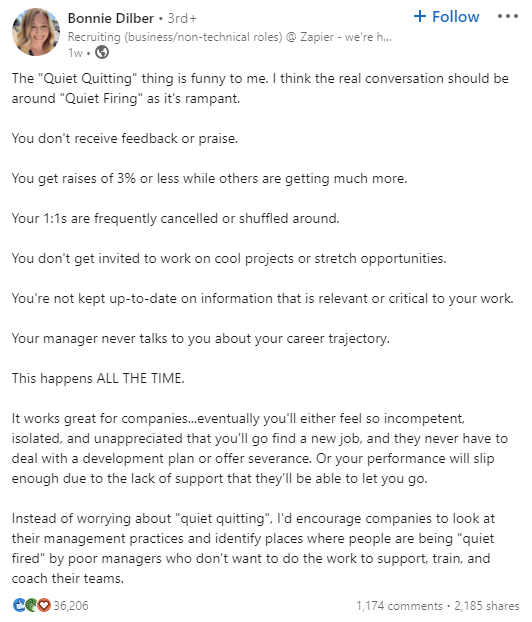Are your employees quiet quitting? Here’s why (and what to do)
A recent Gallup study found that approximately 50% of workers in the United States can be considered a quiet quitter. Gallup goes as far as calling it a quiet quitting crisis, driven by an increasingly disengaged and dissatisfied workforce.
Table of contents
But what is at the root of this shift in the mindset of your employees? And is quiet quitting really a negative crisis that employers have to somehow solve? Or, can you find a way to work with—and benefit from—this workplace trend?
Find out below what quiet quitting is—and perhaps more importantly, what it’s not—and learn about the implications of the movement for your business.
- Is quiet quitting a misnomer? What it is and isn’t
- Why quiet quitting is so popular right now
- Pointing fingers: You reap what you sow
- The employer’s dilemma: Should you oppose quiet quitting?
- 6 tips on how to handle quiet quitting
Is quiet quitting a misnomer? What it is and isn’t
Although there is no clear-cut definition of the term quiet quitting, most people seem to have agreed on a shared meaning of what it refers to. And it generally has nothing to do with actually quitting a job.
Quiet quitting is about more clearly demarcating the boundaries between one’s work and personal life. But while doing so, the quiet quitter still performs the tasks they were hired to do. They just won’t put (much) time and energy into tasks that are beyond the scope of their position and job description.
As Zaid Khan, a 24-year-old engineer from New York, explains in his viral TikTok video that received over three million views in a matter of weeks: “You’re quitting the idea of going above and beyond”.
Rather than putting in 120% every week and working more hours than you’re getting paid for, you stick to what your job description says. Nothing more, but also nothing less.
So the worker can still excel at what they do. They can still drive projects and reach assigned targets and deadlines. They will even still work an hour extra now and then to get a big project over the line. They just won’t take on any additional work or make overtime the norm. It’s about acting your wage.
“You’re quitting the idea of going above and beyond.”
Zaid Khan in his viral TikTok video.
So, quiet quitting is about not going that extra mile anymore. But that doesn’t mean an employee can’t still thrive. Putting healthy boundaries in place isn’t a sign of laziness or unwillingness to work. For many, it’s simply about no longer buying into what has been labelled the “hustle culture”.
Hustle culture or healthy boundaries
Hustle culture is the name given to a rather toxic working mentality characterised by presenteeism and consistently working outside the agreed upon contractual hours and job requirements. The idea is to be more visible in the workplace in order to impress the boss or simply gain attention and praise.
The pressure put on employees in such a culture is often unsustainable, as it can quickly lead to overworking, stress, and burnout. Moreover, employees are seldom rewarded for the extra work they put in (more on this below).
Quiet quitters are fed up with this way of working and instead value a more healthy, sustainable work-life balance.
And note that just because it has now gone viral on TikTok and other social media under the term #quietquitting, this doesn’t mean it is a new phenomenon. The term was first coined in 2009, and there have always been employees who refused to do more than necessary to meet job requirements.
But the fact that it is hitting headlines right now is not coincidental, as we’re witnessing a generational shift in the place work holds in people’s lives.
Why quiet quitting is so popular right now
The Gallup study we mentioned at the beginning of this article noticed that disengagement and dissatisfaction were highest among the younger generations. In particular, Millennials and Gen Z seem to be more inclined to quietly quit. And that makes sense.
Because today’s (younger) workforce feels more empowered to take ownership of their working life. And there are several reasons for that:
- They’re more aware of the risks of overworking, burnout, stress, and the resulting mental health issues.
- Global unrest and times of great uncertainty have all let people reevaluate what is important to them in life, with work-life often playing second fiddle to private life.
- Moreover, employees are more aware of the fragility of life. They don’t want to waste their lives just working rather than focussing on the things that matter most, such as friends, family, and mental and physical health.
- Widespread labour shortages combined with a shift in mindset—in which job hopping is much more acceptable than it used to be—means if you don’t meet demands, the employee can just move on to the next company.
- Furthermore, upskilling and reskilling have become much more common, and (free!) training courses are more readily available, giving employees more freedom to switch if an employer—or whole industry—doesn’t meet their needs.
- The new generation feels empowered and is wearier of blindly following authority and simply taking orders from others. They demand to be treated with the empathy and respect they deserve, or it will be the employer’s loss when they leave.
It all adds up to a drive to more clearly separate one’s career from their identity. Work becomes more a means to an end, rather than a driving vocation or way of life.
Note that different employees have different reasons for quitting quietly. For example, it can also be driven by mental or physical health issues or circumstances in their personal life that drive them to take a step back from work. In this case, instead of taking the time off they actually need, an employee might feel they need to come to the office still (presenteeism).

Pointing fingers: You reap what you sow
As quiet quitting went viral, many employers started labelling “quiet quitters” as lazy, disengaged, unproductive, and even toxic to the work environment.
Another TikToker, posting under the name of the duchess of decorum, went on to call the “hustler mentality” the only way to move forward in your career. In her opinion, quiet quitters will never achieve career success because they’re not putting in the extra effort that’s needed to stand out in the crowd and be recognised by employers.
But this perspective is flipping the conversation, blaming the employees rather than the employers. If an employee is hired to do a certain job for a certain wage, shouldn’t doing what they’re hired for be enough? Why should a person work 60 hours a week, risking overworking and having their life consumed by their job, when they don’t get paid for this (nor receive the recognition)?
Furthermore, promoting such a mentality can lead to a competitive culture that keeps stretching employees further as they try to outperform and outachieve each other in an attempt to gain recognition.
Instead of driving employees to eminent burnout, employers are probably better off supporting their employees in their pursuit of a healthy work-life balance. Moreover, it can also be worth checking if you are not (unconsciously) quiet firing employees.
This viral LinkedIn post by Bonnie Dilber explains the concept of quiet firing perfectly:

So before you consider judging quietly quitting employees, be sure to consider your own potential involvement as well.
The employer’s dilemma: Should you oppose quiet quitting?
Now, the big question is, how do you handle quiet quitting within your organisation?
Your first thought might, logically so, be to reprimand a quiet quitter. Perhaps you want to let them know they should step it up a bit. Or perhaps you consider raising their targets or workload, so they’ll have to put in more hours to still get everything done.
But the problem with this approach is that you risk pushing them from quietly quitting to actually resigning and finding an employer who is more considerate of their needs and preferences. And if we’ve learned anything from the Great Resignation, it’s that employees right now aren’t scared to resign if they’re not happy with their job.
You could also consider showing your appreciation for the employees that do put in the extra hours and work by promoting them over their 9-to-5 mentality colleagues. But this can quickly lead to the aforementioned culture of constant overstretching and trying to impress, leading to overworking and burning out your team.
Instead, we suggest taking a different approach.
6 tips on how to handle quiet quitting
So, how do you go about handling quiet quitting in your organisation? In many cases, it comes down to three key aspects: Transparency, clarity, and flexibility.
1. Communicate clear expectations from the start
This all starts with outlining the requirements for a certain role. What do you need from your employee? What do they need to achieve in their position?
Start with the job description (internally and externally). What is defined as part of the job, and is the employee actually doing this? By being clear from day one, you decrease the chances of a disconnect between expectations and reality.
2. Hold regular one-to-one and review sessions
Have open conversations and regular feedback meetings so that you can start the conversation. Learn how your employees are experiencing the workload assigned to them and why they might not be inclined to work overtime or pick up extra projects.
It could be that they simply want to live a healthier lifestyle with a better work-life balance. But it could also be that they feel like if they do put in the extra mile, they receive little to no recognition for their added effort.
Foster a workplace culture of psychological safety where your employees feel safe and empowered to share their honest opinion. Listen to their opinion and try to meet their needs or meet them halfway.
Find ways to keep your employees actively engaged and motivated, even if it means they only stick to the hours you pay them. And after all, isn’t that just the fair and just thing to do? It is their life, and they are allowed to stay within the requirements outlined in the job.
Furthermore, if an employee has made their mind up about not wanting to put in the extra (unpaid) time, trying to force them will likely only work counterproductively. If they notice you’re still expecting more, chances are they’ll start looking elsewhere.
Now you may think to yourself, good riddance! The problem is that having to find, attract, and hire great talent is often time and cost-consuming, especially in today’s global climate. In most cases, it’ll be better to accept and respect their decision—as long as they still perform the tasks stipulated in their job description, of course.
In fact, showing them that you respect their boundaries is likely to have a positive impact on their drive and output within those boundaries.
3. Is a one-person job actually a two-person job?
If you require more from them, consider hiring a new team member (or see if there’s someone else on your team already) to share the workload instead. Forcing them to work more than they want will only strain the employee-employer relationship and increase the chances of them resigning.
This is bad for employee retention and will mean you end up with even fewer employee hours at your disposal. So it might be necessary to reevaluate the job requirements and see how this workload can be redistributed or if a new hire has to be taken on board.
Need help finding and hiring top talent
JOIN's talent attraction software lets you hire faster
Find out more4. Provide an example for your employees
They always say it’s good to lead by example. In the previous points, we tried to somehow handle the situation by reacting. Instead, you can also consider proactively leading the way towards a healthier work-life balance.
Show your employees that it’s OK to not work overtime, not check their emails on the weekend, and not respond to evening Slack messages.
And this goes beyond just saying these things. Instead, act accordingly. Leave the office at reasonable times and be clear about the fact that you’re logging off for the day.
Even if you still have to finish up some work in the evening or on the weekend—if you’re the CEO, this is often simply unavoidable—try not to show this to your employees. For example, set your status on tools like Slack or Teams to offline. Schedule emails you write to be sent the next morning, instead of sending them late in the evening.
5. Show appreciation for the work that’s achieved
As we’ve seen, quiet quitting (generally) doesn’t equate to being lazy. Chances are, your quietly quitting employee is in fact still delivering the work they were hired to do.
Managers can sometimes focus too much on reserving their praise for the employees who work the longest hours to finish projects or reach (sometimes unreasonable) deadlines. Instead, try to focus your praise on the work that’s done within the normal hours of work as well.
Celebrate the great work someone delivers while still maintaining a healthy work-life balance. Praise how they manage their time and work efficiently to enable themselves to not overwork but still deliver excellent work.
Go a step further and promote it as an example for other employees to learn from. What can the team learn from the way this employee works to be more efficient?
6. Provide a purpose and a reason to stay invested
Lastly, focus on giving your employees a purpose in the work they do. Give them the power to achieve their (and your) career goals.
Here, it’s key that you outline a personal development plan with your employee to see how they can progress their career. Set goals for them to acquire new skills—both hard skills and soft skills—and invest in training and development.
This will give them more sense of purpose and fulfilment in the work they do. And although some will still make sure they achieve their goals within their contractual hours, giving a purpose might mean they’re less reluctant to put in an hour extra now and then.
Quiet quitting is here to stay
The truth is, chances are that quiet quitting is here to stay and will only gain more momentum and intensity. The new generations of workers are more demanding and feel more empowered to leave an employer who doesn’t treat them the way they want to be treated.
That’s why, instead of trying to fight the shift and force employees to put in extra work—risking a wave of resignations as a result—you’re probably better off going with the flow. Praise the work they do and try to keep your employees motivated and engaged, regardless of whether they work overtime or not.
Want to learn more about keeping employees motivated? Then check out our article on how to improve employee engagement!
Frans Lelivelt
Frans is JOIN's multilingual Senior Content Manager. His main topic of interest in the recruitment space is DEI and how companies can reduce their (unconscious) biases to make the world of work a fairer, kinder place for everyone. Outside of work, he tries to do the same for animals, spending much of his spare time in the kitchen preparing plant-based feasts.


